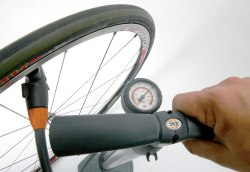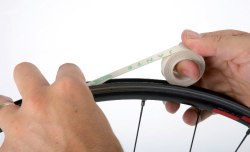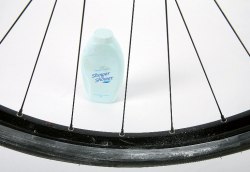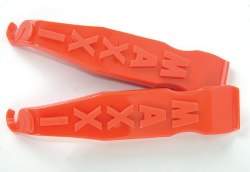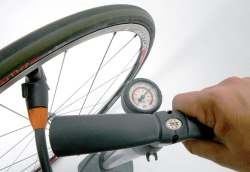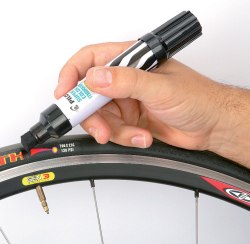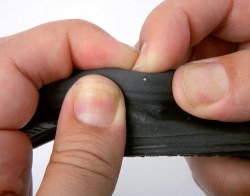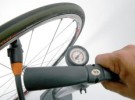Punctures happen; it’s a fact of life. However, a number of things can be done to reduce the risk. Here are a few ideas that you may choose to take on board.
Preventing Punctures
Go Ahead to part 2 >>
Rim Tape
To begin with, a few important set-up tips can help minimise those pesky punctures. Poor quality rim tape poses a major puncture risk; any holes or cracks near the spoke holes will allow the inner tube to rupture under pressure as it is forced into the rim cavity. Fit good quality high-pressure rim tape and you’ll prevent this type of puncture. Ignore this point if your wheels lack spoke holes on the inner surface but remove any sharp edges that could damage the inner tube.
Talc on the Tube
While its effectiveness is debatable, a light coat of talcum powder on the inner tube can help it slip into place and neatly seat itself in the tyre casing—this in itself is a very important thing. Proponents say that a little talc on the tube will reduce friction and allow the tube to move within the tyre, lessening the chance of punctures. Talc or otherwise, it is important to slightly inflate the inner tube when fitting it and position the tube evenly around the tyre with no pinches or folds.
Tyre Levers
Ideally you should only use your hands when mounting standard clincher tyres. Using the correct technique should allow you to get the bead in place without tyre levers. However, some tyre/rim combinations are so tight that mounting can prove difficult, even with good technique and some riders may not have sufficient hand strength. If you have to use tyre levers, use good ones and use them very carefully. Flat, broad nylon levers minimise the chance of tyre damage but care needs to be taken not to pinch the inner tube.
Inflation Pressure
Using an appropriate air pressure for your tyres and road conditions can play a major role in puncture prevention. Too low and you may pinch the inner tube if you hit a pothole. Too high and you increase the risk of penetration punctures. Around 100psi is a good starting point for most but consult the recommended pressure printed on your tyre. Always analyse your punctured inner tubes to see whether you have a potential issue in this area. Pinch flat punctures appear as two holes on opposing inner and outer surfaces of the tube—they are often referred to as a ‘snake bite’ which gives you some idea of what to look for. Fatter tyres will also reduce the risk of pinch flats.
Problem Detection
Mark the tyre immediately next to the valve stem. Knowing where the tyre was positioned in relation to the tube will help when trying to track down any problem punctures. Once you’ve found the hole in the tube, line the valve up with the mark on the tyre and you will know where the tyre casing was pierced. From there you can closely check both the rim and tyre for damage that may cause recurring punctures.
Caught Red Handed
Whenever you get a puncture, it pays to inspect the tyre casing very closely. The glass, wire or thorn that penetrated the tyre may still be stuck in the casing—just waiting to puncture again… Marking the tyre as shown will help in locating the problem spot and some care needs to be taken not to cut your fingers when feeling around for any sharp objects. You may have to dig a little in any cuts as glass can be wedged deep in the tyre where it isn’t easily seen.
Go Ahead to part 2 >>
